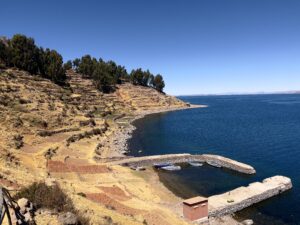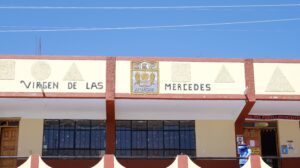I.E.P N°70037 “Virgen de las Mercedes”, Pueblo, Amantani Island, Lake Titicaca, Peru September 2022
The “Virgen de las Mercedes” primary school is located on a small Peruvian island of less than ten square kilometers in area on the shores of Lake Titicaca. This island in the Peruvian Altiplano perched at an altitude of 3900 meters is called the island of Amantaní. It is home to approximately 3,700 inhabitants divided into 10 different communities.

Located 40 km from the city of Puno, the island of Amantaní is an essential tourist destination when it comes to Lake Titicaca on the Peruvian side. It can be reached by boat from Puno or from Chifrón beach. The communities living there preserve their customs and a traditional way of life. Beyond its relatively small tourist activity, people live there from their crafts, agriculture and fishing.
In the square of the main village of the island of Amantaní, next to the church and opposite the town hall, there is a large building whose facade is made of large, decorated arches. Resounding from the walls of the building, we hear the laughter and cries of children having fun. This infrastructure is called “I.E.P N•70037 “Virgen de las Mercedes””. It is the primary school of the main village of the island of Amantaní. This school welcomes around 100 children from 5 to 11 years old and covers levels from primero (1°) grado to sexto (6°) grado, the Peruvian equivalent of “CP” and “sixième” grade levels in France.

The “Virgen de las Mercedes” primary school is the main school on the island that hosts the largest number of students, but it is not the only one. Two other communities on the island also have primary schools, the Occosuyo community has one public primary school and the Sancayuni community has one public primary school and one private primary school. Each community has a kindergarten. A secondary school is also present a few houses from the public primary school in the main village of the island. However, to pursue higher studies (universities, schools or institutes of higher studies) students must go to the mainland in Capachica, the nearest town to the island or in the large towns of Juliaca and Puno.

Classes at the public school of Amantaní do not have many students, between 15 and 18 students per class. The teaching of the different subjects is done in Spanish. Indeed, despite the traditional way of life of the island’s Quechua communities and although most adults on the island speak Quechua, few children speak this language. Students are however able to understand Quechua for the most part. At school, teachers incorporate texts, poems and songs in Quechua into their teaching so that students learn more about their culture of origin and its customs. It is important for the school that the children continue to learn the Quechua language and the customs of the island of Amantaní so that their culture does not fade over time.
Due to the insular and mountainous nature, the access roads are difficult to develop and the only roads that the island has are not passable by car because they are too steep and narrow. The children who come to school therefore all come to school on foot from the main village on the island of Amantaní and from a few other communities quite physically close to the main village.

In addition, the teaching staff, administrative staff and maintenance staff of the school do not really live on the island. They stay in dormitories on the island of Amantaní during the week and return home to the mainland on weekends. Indeed, due to the lack of professional activity on the island, it is complicated to live there without cultivating the land or raising animals. Thus, it is difficult to settle there and build your family life there if you are not from the island.

Although the island of Amantaní has few direct contacts with the land, it is frequented by many tourists from different countries. Thus, the children see many foreigners but few of them stop to discuss and exchange with the children of the island. However, they are very curious and want to learn more about countries other than their own and cultures other than their own. We had the opportunity to spend a few moments with the students of the quinto (5°) grado of the public primary school “Virgen de las Mercedes”. They were very happy to discuss our different cultures, to learn a little more about school and life in France and to learn a few words in French.